Disruption of the Atlantic Meridional Circulation during Deglacial Climates Inferred from Planktonic Foraminiferal Shell Weights
Abstract
1. Introduction
2. Oceanographic Setting of the Core Locations
3. Material and Methods
3.1. Sediment Core Locations and Methodological Overview
3.2. Weight Analysis
3.3. Determination of Atlantic Seawater Paleodensity
3.4. X-ray Micro-Computed Tomography (μCT)
4. Results
5. Discussion
5.1. Foraminifera Shell Weights Are Tracers of Past Oceanic Circulation
5.2. Assessing Atlantic Planktonic Foraminifera Shell Mass Records as Seawater Density and AMOC Proxies
6. Conclusions
Supplementary Materials
Funding
Data Availability Statement
Acknowledgments
Conflicts of Interest
References
- Sigman, D.M.; Hain, M.P.; Haug, G.H. The polar ocean and glacial cycles in atmospheric CO2 concentration. Nature 2010, 466, 47–55. [Google Scholar] [CrossRef] [PubMed]
- Srokosz, M.A.; Bryden, H.L. Observing the Atlantic Meridional Overturning Circulation yields a decade of inevitable surprises. Science 2015, 348, 1255575. [Google Scholar] [CrossRef] [PubMed]
- Wunsch, C. What Is the Thermohaline Circulation? Science 2002, 298, 1179–1181. [Google Scholar] [CrossRef] [PubMed]
- Fedorov, A.; Barreiro, M.; Boccaletti, G.; Pacanowski, R.; Philander, S.G. The Freshening of Surface Waters in High Latitudes: Effects on the Thermohaline and Wind-Driven Circulations. J. Phys. Oceanogr. 2007, 37, 896–907. [Google Scholar] [CrossRef][Green Version]
- McManus, J.F.; Francois, R.; Gherardi, J.M.; Keigwin, L.D.; Brown-Leger, S. Collapse and rapid resumption of Atlantic meridional circulation linked to deglacial climate changes. Nature 2004, 428, 834–837. [Google Scholar] [CrossRef]
- Robinson, L.F.; Adkins, J.F.; Keigwin, L.D.; Southon, J.; Fernandez, D.P.; Wang, S.-L.; Scheirer, D.S. Radiocarbon Variability in the Western North Atlantic During the Last Deglaciation. Science 2005, 310, 1469–1473. [Google Scholar] [CrossRef]
- Rogerson, M.; Bigg, G.R.; Rohling, E.J.; Ramirez, J. Vertical density gradient in the eastern North Atlantic during the last 30,000 years. Clim. Dyn. 2012, 39, 589–598. [Google Scholar] [CrossRef]
- Lynch-Stieglitz, J.; Adkins, J.F.; Curry, W.B.; Dokken, T.; Hall, I.R.; Herguera, J.C.; Hirschi, J.J.-M.; Ivanova, E.V.; Kissel, C.; Marchal, O.; et al. Atlantic Meridional Overturning Circulation During the Last Glacial Maximum. Science 2007, 316, 66–69. [Google Scholar] [CrossRef]
- Lipps, J.H. Ecology and Paleoecology of Planktic Foraminifera. In Foraminiferal Ecology and Paleoecology; Lipps, J.H., Berger, W.H., Buzas, M.A., Douglas, R.G., Ross, C.A., Eds.; SEPM Society for Sedimentary Geology: Tulsa, OK, USA, 1979; Volume 6, pp. 62–104. [Google Scholar]
- Hemleben, C.; Anderson, O.R.; Spindler, M. Modern Planktonic Foraminifera; Springer: New York, NY, USA, 1989. [Google Scholar]
- Emiliani, C. Depth habitats of some species of pelagic foraminifera as indicated by oxygen isotope ratios. Am. J. Sci. 1954, 252, 149–158. [Google Scholar] [CrossRef]
- de Nooijer, L.J.; Toyofuku, T.; Kitazato, H. Foraminifera promote calcification by elevating their intracellular pH. Proc. Natl. Acad. Sci. USA 2009, 106, 15374–15378. [Google Scholar] [CrossRef]
- Toyofuku, T.; Matsuo, M.Y.; de Nooijer, L.J.; Nagai, Y.; Kawada, S.; Fujita, K.; Reichart, G.-J.; Nomaki, H.; Tsuchiya, M.; Sakaguchi, H.; et al. Proton pumping accompanies calcification in foraminifera. Nat. Commun. 2017, 8, 14145. [Google Scholar] [CrossRef]
- Erez, J. Vital effect on stable-isotope composition seen in foraminifera and coral skeletons. Nature 1978, 273, 199–202. [Google Scholar] [CrossRef]
- Marszalek, D.S. The role of heavy skeletons in vertical movements of non-motile zooplankton. Mar. Behav. Physiol. 1982, 8, 295–303. [Google Scholar] [CrossRef]
- Campbell, R.W.; Dower, J.F. Role of lipids in the maintenance of neutral buoyancy by zooplankton. Mar. Ecol. Prog. Ser. 2003, 263, 93–99. [Google Scholar] [CrossRef]
- Zarkogiannis, S.D.; Antonarakou, A.; Tripati, A.; Kontakiotis, G.; Mortyn, P.G.; Drinia, H.; Greaves, M. Influence of surface ocean density on planktonic foraminifera calcification. Sci. Rep. 2019, 9, 533. [Google Scholar] [CrossRef]
- Embley, R.W.; Morley, J.J. Quaternary sedimentation and paleoenvironmental studies off Namibia (South-West Africa). Mar. Geol. 1980, 36, 183–204. [Google Scholar] [CrossRef]
- De Ruijter, W.P.M.; Biastoch, A.; Drijfhout, S.S.; Lutjeharms, J.R.E.; Matano, R.P.; Pichevin, T.; van Leeuwen, P.J.; Weijer, W. Indian-Atlantic interocean exchange: Dynamics, estimation and impact. J. Geophys. Res. 1999, 104, 20885–20910. [Google Scholar] [CrossRef]
- Garzoli, S.L.; Gordon, A.L. Origins and variability of the Benguela Current. J. Geophys. Res. 1996, 101, 897–906. [Google Scholar] [CrossRef]
- Lutjeharms, J.R.E. The exchange of water between the South Indian and South Atlantic Oceans. In The South Atlantic: Present and Past Circulation; Wefer, G., Berger, W.H., Siedler, G., Webb, D.J., Eds.; Springer: Berlin/Heidelberg, Germany, 1996; pp. 125–162. [Google Scholar]
- Bainbridge, A.E. GEOSECS Atlantic Expedition: Sections and Profiles; National Science Foundation: Washington, DC, USA, 1980.
- Broecker, W.; Blanton, S.; Smethie, W.M., Jr.; Ostlund, G. Radiocarbon decay and oxygen utilization in the Deep Atlantic Ocean. Glob. Biogeochem. Cycles 1991, 5, 87–117. [Google Scholar] [CrossRef]
- Stramma, L.; England, M. On the water masses and mean circulation of the South Atlantic Ocean. J. Geophys. Res. 1999, 104, 20863–20883. [Google Scholar] [CrossRef]
- Reid, J.L. On the total geostrophic circulation of the South Atlantic Ocean: Flow patterns, tracers, and transports. Prog. Oceanogr. 1989, 23, 149–244. [Google Scholar] [CrossRef]
- Sloyan, B.M. Antarctic bottom and lower circumpolar deep water circulation in the eastern Indian Ocean. J. Geophys. Res. 2006, 111, C02006. [Google Scholar] [CrossRef]
- Dittert, N.; Henrich, R. Carbonate dissolution in the South Atlantic Ocean: Evidence from ultrastructure breakdown in Globigerina bulloides. Deep Sea Res. Part 1 Oceanogr. Res. Pap. 2000, 47, 603–620. [Google Scholar] [CrossRef]
- Christl, M.; Mangini, A. Water mass properties and circulation in the Cape Basin. A multiproxy approach. Geochim. Cosmochim. Acta 2009, 73, A224. [Google Scholar]
- Volbers, A.N.A.; Henrich, R. Late Quaternary variations in calcium carbonate preservation of deep-sea sediments in the northern Cape Basin: Results from a multiproxy approach. Mar. Geol. 2002, 180, 203–220. [Google Scholar] [CrossRef]
- Aouni, A.E.; Daoudi, K.; Yahia, H.; Minaoui, K.; Benazzouz, A. Surface mixing and biological activity in the North-West African upwelling. Chaos Interdiscip. J. Nonlinear Sci. 2019, 29, 011104. [Google Scholar] [CrossRef]
- Mittelstaedt, E. The ocean boundary along the northwest African coast: Circulation and oceanographic properties at the sea surface. Prog. Oceanogr. 1991, 26, 307–355. [Google Scholar] [CrossRef]
- Stramma, L.; Hόttl, S.; Schafstall, J. Water masses and currents in the upper tropical northeast Atlantic off northwest Africa. J. Geophys. Res. 2005, 110, C12006. [Google Scholar] [CrossRef]
- Howe, J.N.W.; Piotrowski, A.M.; Noble, T.L.; Mulitza, S.; Chiessi, C.M.; Bayon, G. North Atlantic Deep Water Production during the Last Glacial Maximum. Nat. Commun. 2016, 7, 11765. [Google Scholar] [CrossRef]
- Didié, C.; Bauch, H.A. Species composition and glacial-interglacial variations in the ostracode fauna of the northeast Atlantic during the past 200,000 years. Mar. Micropaleontol. 2000, 40, 105–129. [Google Scholar] [CrossRef]
- Broecker, W.S. Thermohaline circulation, the Achilles heel of our climate system: Will man-made CO2 upset the current balance? Science 1997, 278, 1582–1588. [Google Scholar] [CrossRef] [PubMed]
- Hansen, B.; Østerhus, S.; Quadfasel, D.; Turrell, W. Already the day after tomorrow? Science 2004, 305, 953–954. [Google Scholar] [CrossRef] [PubMed]
- Kawase, M.; Sarmiento, J.L. Circulation and nutrients in middepth Atlantic waters. J. Geophys. Res. 1986, 91, 9749–9770. [Google Scholar] [CrossRef]
- Manighetti, B.; McCave, I.N. Late glacial and Holocene palaeocurrents around Rockall Bank, NE Atlantic Ocean. Paleoceanography 1995, 10, 611–626. [Google Scholar] [CrossRef]
- Barker, S.; Archer, D.; Booth, L.; Elderfield, H.; Henderiks, J.; Rickaby, R.E.M. Globally increased pelagic carbonate production during the Mid-Brunhes dissolution interval and the CO2 paradox of MIS 11. Quat. Sci. Rev. 2006, 25, 3278–3293. [Google Scholar] [CrossRef]
- Zarkogiannis, S.D.; Antonarakou, A.; Fernandez, V.; Mortyn, P.G.; Kontakiotis, G.; Drinia, H.; Greaves, M. Evidence of stable foraminifera biomineralization during the last two climate cycles in the tropical Atlantic Ocean. J. Mar. Sci. Eng. 2020, 8, 737. [Google Scholar] [CrossRef]
- Schmiedl, G.; Mackensen, A. Age model of sediment core GeoB1710-3. PANGAEA 1997. [Google Scholar] [CrossRef]
- Volbers, A.N.A.; Niebler, H.S.; Giraudeau, J.; Schmidt, H.; Henrich, R. Paleoceanographic changes in the northern Benguela upwelling system over the last 245.000 years as derived from planktic foraminifera assemblages. In The South Atlantic in the Late Quaternary: Reconstruction of Material Budget and Current Systems; Wefer, G., Mulitza, S., Ratmeyer, V., Eds.; Springer: Berlin/Heidelberg, Germany; New York, NY, USA, 2004; pp. 601–622. [Google Scholar]
- Barker, S.; Kiefer, T.; Elderfield, H. Temporal changes in North Atlantic circulation constrained by planktonic foraminiferal shell weights. Paleoceanography 2004, 19, PA3008. [Google Scholar] [CrossRef]
- Volbers, A.N.A.; Henrich, R. Present water mass calcium carbonate corrosiveness in the eastern South Atlantic inferred from ultrastructural breakdown of Globigerina bulloides in surface sediments. Mar. Geol. 2002, 186, 471–486. [Google Scholar] [CrossRef]
- Zarkogiannis, S.D.; Kontakiotis, G.; Gkaniatsa, G.; Kuppili, V.S.C.; Marathe, S.; Wanelik, K.; Lianou, V.; Besiou, E.; Makri, P.; Antonarakou, A. An Improved Cleaning Protocol for Foraminiferal Calcite from Unconsolidated Core Sediments: HyPerCal—A New Practice for Micropaleontological and Paleoclimatic Proxies. J. Mar. Sci. Eng. 2020, 8, 998. [Google Scholar] [CrossRef]
- Broecker, W.; Clark, E. An evaluation of Lohmann’s Foraminifera weight dissolution index. Paleoceanography 2001, 16, 531–534. [Google Scholar] [CrossRef]
- Zarkogiannis, S.; Fernandez, V.; Greaves, M.; Mortyn, P.G.; Kontakiotis, G.; Antonarakou, A. X-ray tomographic data of planktonic foraminifera species Globigerina bulloides from the Eastern Tropical Atlantic across Termination II. Gigabyte 2020, 1. [Google Scholar] [CrossRef]
- Iwasaki, S.; Kimoto, K.; Sasaki, O.; Kano, H.; Uchida, H. Sensitivity of planktic foraminiferal test bulk density to ocean acidification. Sci. Rep. 2019, 9, 9803. [Google Scholar] [CrossRef]
- Cheng, J.; Liu, Z.; Zhang, S.; Liu, W.; Dong, L.; Liu, P.; Li, H. Reduced interdecadal variability of Atlantic Meridional Overturning Circulation under global warming. Proc. Natl. Acad. Sci. USA 2016, 113, 3175–3178. [Google Scholar] [CrossRef]
- Schenk, F.; Väliranta, M.; Muschitiello, F.; Tarasov, L.; Heikkilä, M.; Björck, S.; Brandefelt, J.; Johansson, A.V.; Näslund, J.-O.; Wohlfarth, B. Warm summers during the Younger Dryas cold reversal. Nat. Commun. 2018, 9, 1634. [Google Scholar] [CrossRef]
- Zarkogiannis, S.D.; Kontakiotis, G.; Antonarakou, A.; Mortyn, P.G.; Drinia, H. Latitudinal Variation of Planktonic Foraminifera Shell Masses During Termination I. IOP Conf. Ser. Earth Environ. Sci. 2019, 221, 12052. [Google Scholar] [CrossRef]
- Gordon, A.L.; Piola, A.R. Atlantic Ocean Upper Layer Salinity Budget. J. Phys. Oceanogr. 1983, 13, 1293–1300. [Google Scholar] [CrossRef]
- Johnson, G.C.; Schmidtko, S.; Lyman, J.M. Relative contributions of temperature and salinity to seasonal mixed layer density changes and horizontal density gradients. J. Geophys. Res. Ocean. 2012, 117. [Google Scholar] [CrossRef]
- Deininger, M.; McDermott, F.; Cruz, F.W.; Bernal, J.P.; Mudelsee, M.; Vonhof, H.; Millo, C.; Spötl, C.; Treble, P.C.; Pickering, R.; et al. Inter-Hemispheric synchroneity of Holocene precipitation anomalies controlled by Earth’s latitudinal insolation gradients. Nat. Commun. 2020, 11, 5447. [Google Scholar] [CrossRef]
- Davis, B.A.S.; Brewer, S. Orbital forcing and role of the latitudinal insolation/temperature gradient. Clim. Dyn. 2009, 32, 143–165. [Google Scholar] [CrossRef]
- Stokes, S.; Haynes, G.; Thomas, D.S.G.; Horrocks, J.L.; Higginson, M.; Malifa, M. Punctuated aridity in southern Africa during the last glacial cycle: The chronology of linear dune construction in the northeastern Kalahari. Palaeogeogr. Palaeoclimatol. Palaeoecol. 1998, 137, 305–322. [Google Scholar] [CrossRef]
- Fuhrmann, F.; Diensberg, B.; Gong, X.; Lohmann, G.; Sirocko, F. Aridity synthesis for eight selected key regions of the global climate system during the last 60 000 years. Clim. Past 2020, 16, 2221–2238. [Google Scholar] [CrossRef]
- Tierney, J.E.; deMenocal, P.B.; Zander, P.D. A climatic context for the out-of-Africa migration. Geology 2017, 45, 1023–1026. [Google Scholar] [CrossRef]
- Lisiecki, L.E.; Raymo, M.E. A Pliocene-Pleistocene stack of 57 globally distributed benthic δ18O records. Paleoceanography 2005, 20, PA1003. [Google Scholar] [CrossRef]
- Rohling, E.J.; Fenton, M.; Jorissen, F.J.; Bertrand, P.; Ganssen, G.; Caulet, J.P. Magnitudes of sea-level lowstands of the past 500,000 years. Nature 1998, 394, 162–165. [Google Scholar] [CrossRef]
- Heinrich, H. Origin and consequences of cyclic ice rafting in the Northeast Atlantic Ocean during the past 130,000 years. Quat. Res. 1988, 29, 142–152. [Google Scholar] [CrossRef]
- McManus, J.F.; Oppo, D.W.; Cullen, J.L. A 0.5-Million-Year Record of Millennial-Scale Climate Variability in the North Atlantic. Science 1999, 283, 971–975. [Google Scholar] [CrossRef]
- Margari, V.; Skinner, L.C.; Tzedakis, P.C.; Ganopolski, A.; Vautravers, M.; Shackleton, N.J. The nature of millennial-scale climate variability during the past two glacial periods. Nat. Geosci. 2010, 3, 127–131. [Google Scholar] [CrossRef]
- Hodell, D.A.; Channell, J.E.T.; Curtis, J.H.; Romero, O.E.; Röhl, U. Onset of “Hudson Strait” Heinrich events in the eastern North Atlantic at the end of the middle Pleistocene transition (∼640 ka)? Paleoceanography 2008, 23. [Google Scholar] [CrossRef]
- Chappell, J. Sea level changes forced ice breakouts in the Last Glacial cycle: New results from coral terraces. Quat. Sci. Rev. 2002, 21, 1229–1240. [Google Scholar] [CrossRef]
- Martínez-Méndez, G.; Zahn, R.; Hall, I.R.; Peeters, F.J.C.; Pena, L.D.; Cacho, I.; Negre, C. Contrasting multiproxy reconstructions of surface ocean hydrography in the Agulhas Corridor and implications for the Agulhas Leakage during the last 345,000 years. Paleoceanography 2010, 25, PA4227. [Google Scholar] [CrossRef]
- Reid, J.L. On the temperature, salinity, and density differences between the Atlantic and Pacific oceans in the upper kilometre. Deep Sea Res. 1961, 7, 265–275. [Google Scholar] [CrossRef]
- Marchal, O.; François, R.; Stocker, T.F.; Joos, F. Ocean thermohaline circulation and sedimentary 231Pa/230Th ratio. Paleoceanography 2000, 15, 625–641. [Google Scholar] [CrossRef]
- Mokeddem, Z.; McManus, J.F.; Oppo, D.W. Oceanographic dynamics and the end of the last interglacial in the subpolar North Atlantic. Proc. Natl. Acad. Sci. USA 2014, 111, 11263–11268. [Google Scholar] [CrossRef]
- Irvalı, N.; Ninnemann, U.S.; Kleiven, H.F.; Galaasen, E.V.; Morley, A.; Rosenthal, Y. Evidence for regional cooling, frontal advances, and East Greenland Ice Sheet changes during the demise of the last interglacial. Quat. Sci. Rev. 2016, 150, 184–199. [Google Scholar] [CrossRef]
- Guihou, A.; Pichat, S.; Govin, A.; Nave, S.; Michel, E.; Duplessy, J.-C.; Telouk, P.; Labeyrie, L. Enhanced Atlantic Meridional Overturning Circulation supports the Last Glacial Inception. Quat. Sci. Rev. 2011, 30, 1576–1582. [Google Scholar] [CrossRef]
- Labeyrie, L.D.; Duplessy, J.C.; Blanc, P.L. Variations in mode of formation and temperature of oceanic deep waters over the past 125,000 years. Nature 1987, 327, 477–482. [Google Scholar] [CrossRef]
- Johnsen, S.J.; Dahl-Jensen, D.; Gundestrup, N.; Steffensen, J.P.; Clausen, H.B.; Miller, H.; Masson-Delmotte, V.; Sveinbjörnsdottir, A.E.; White, J. Oxygen isotope and palaeotemperature records from six Greenland ice-core stations: Camp Century, Dye-3, GRIP, GISP2, Renland and NorthGRIP. J. Quat. Sci. 2001, 16, 299–307. [Google Scholar] [CrossRef]
- McManus, J.F.; Oppo, D.W.; Keigwin, L.D.; Cullen, J.L.; Bond, G.C. Thermohaline Circulation and Prolonged Interglacial Warmth in the North Atlantic. Quat. Res. 2017, 58, 17–21. [Google Scholar] [CrossRef]
- Risebrobakken, B.; Dokken, T.; Jansen, E. Extent and Variability of the Meridional Atlantic Circulation in the Eastern Nordic Seas During Marine Isotope Stage 5 and its Influence on the Inception of the Last Glacial. In The Nordic Seas: An Integrated Perspective; American Geophysical Union: Washington, DC, USA, 2005; pp. 323–339. [Google Scholar] [CrossRef]
- Khodri, M.; Leclainche, Y.; Ramstein, G.; Braconnot, P.; Marti, O.; Cortijo, E. Simulating the amplification of orbital forcing by ocean feedbacks in the last glaciation. Nature 2001, 410, 570–574. [Google Scholar] [CrossRef]
- Tomczak, M.; Godfrey, J.S. Water mass formation, subduction, and the oceanic heat budget. In Regional Oceanography; Tomczak, M., Godfrey, J.S., Eds.; Pergamon: Amsterdam, The Netherlands, 1994; pp. 53–65. [Google Scholar] [CrossRef]
- Roberts, J.; Gottschalk, J.; Skinner, L.C.; Peck, V.L.; Kender, S.; Elderfield, H.; Waelbroeck, C.; Vázquez Riveiros, N.; Hodell, D.A. Evolution of South Atlantic density and chemical stratification across the last deglaciation. Proc. Natl. Acad. Sci. USA 2016, 113, 514–519. [Google Scholar] [CrossRef]
- Yu, E.-F.; Francois, R.; Bacon, M.P. Similar rates of modern and last-glacial ocean thermohaline circulation inferred from radiochemical data. Nature 1996, 379, 689–694. [Google Scholar] [CrossRef]
- Bond, G.; Heinrich, H.; Broecker, W.; Labeyrie, L.; McManus, J.; Andrews, J.; Huon, S.; Jantschik, R.; Clasen, S.; Simet, C.; et al. Evidence for massive discharges of icebergs into the North Atlantic ocean during the last glacial period. Nature 1992, 360, 245–249. [Google Scholar] [CrossRef]
- Bard, E.; Rostek, F.; Turon, J.-L.; Gendreau, S. Hydrological Impact of Heinrich Events in the Subtropical Northeast Atlantic. Science 2000, 289, 1321–1324. [Google Scholar] [CrossRef]
- Duplessy, J.C.; Labeyrie, L.; Arnold, M.; Paterne, M.; Duprat, J.; van Weering, T.C.E. Changes in surface salinity of the North Atlantic Ocean during the last deglaciation. Nature 1992, 358, 485–488. [Google Scholar] [CrossRef]
- Vidal, L.; Labeyrie, L.; Cortijo, E.; Arnold, M.; Duplessy, J.C.; Michel, E.; Becqué, S.; van Weering, T.C.E. Evidence for changes in the North Atlantic Deep Water linked to meltwater surges during the Heinrich events. Earth Planet. Sci. Lett. 1997, 146, 13–27. [Google Scholar] [CrossRef]
- Elliot, M.; Labeyrie, L.; Duplessy, J.-C. Changes in North Atlantic deep-water formation associated with the Dansgaard–Oeschger temperature oscillations (60–10 ka). Quat. Sci. Rev. 2002, 21, 1153–1165. [Google Scholar] [CrossRef]
- Lippold, J.; Gutjahr, M.; Blaser, P.; Christner, E.; de Carvalho Ferreira, M.L.; Mulitza, S.; Christl, M.; Wombacher, F.; Böhm, E.; Antz, B.; et al. Deep water provenance and dynamics of the (de)glacial Atlantic meridional overturning circulation. Earth Planet. Sci. Lett. 2016, 445, 68–78. [Google Scholar] [CrossRef]
- Lynch-Stieglitz, J. The Atlantic Meridional Overturning Circulation and Abrupt Climate Change. Ann. Rev. Mar. Sci. 2017, 9, 83–104. [Google Scholar] [CrossRef]
- Oppo, D.W.; Gebbie, G.; Huang, K.-F.; Curry, W.B.; Marchitto, T.M.; Pietro, K.R. Data Constraints on Glacial Atlantic Water Mass Geometry and Properties. Paleoceanogr. Paleoclimatol. 2018, 33, 1013–1034. [Google Scholar] [CrossRef]
- Lippold, J.; Pöppelmeier, F.; Süfke, F.; Gutjahr, M.; Goepfert, T.J.; Blaser, P.; Friedrich, O.; Link, J.M.; Wacker, L.; Rheinberger, S.; et al. Constraining the Variability of the Atlantic Meridional Overturning Circulation During the Holocene. Geophys. Res. Lett. 2019, 46, 11338–11346. [Google Scholar] [CrossRef]
- Keigwin, L.D.; Boyle, E.A. Detecting Holocene changes in thermohaline circulation. Proc. Natl. Acad. Sci. USA 2000, 97, 1343–1346. [Google Scholar] [CrossRef] [PubMed]
- Oppo, D.W.; McManus, J.F.; Cullen, J.L. Deepwater variability in the Holocene epoch. Nature 2003, 422, 277. [Google Scholar] [CrossRef] [PubMed]
- Caesar, L.; Rahmstorf, S.; Robinson, A.; Feulner, G.; Saba, V. Observed fingerprint of a weakening Atlantic Ocean overturning circulation. Nature 2018, 556, 191–196. [Google Scholar] [CrossRef]
- Rahmstorf, S.; Box, J.E.; Feulner, G.; Mann, M.E.; Robinson, A.; Rutherford, S.; Schaffernicht, E.J. Exceptional twentieth-century slowdown in Atlantic Ocean overturning circulation. Nat. Clim. Chang. 2015, 5, 475–480. [Google Scholar] [CrossRef]
- Thornalley, D.J.R.; Oppo, D.W.; Ortega, P.; Robson, J.I.; Brierley, C.M.; Davis, R.; Hall, I.R.; Moffa-Sanchez, P.; Rose, N.L.; Spooner, P.T.; et al. Anomalously weak Labrador Sea convection and Atlantic overturning during the past 150 years. Nature 2018, 556, 227–230. [Google Scholar] [CrossRef]
- Argo. Argo Float Data and Metadata from Global Data Assembly Centre (Argo GDAC). SEANOE: 2000. Available online: https://www.seanoe.org/data/00311/42182/ (accessed on 1 February 2021). [CrossRef]
- Mortyn, P.G.; Charles, C.D. Planktonic foraminiferal depth habitat and δ18O calibrations: Plankton tow results from the Atlantic sector of the Southern Ocean. Paleoceanography 2003, 18, 1037. [Google Scholar] [CrossRef]
- Saraswat, R.; Khare, N. Deciphering The Modern Calcification Depth Of Globigerina Bulloides In The Southwestern Indian Ocean From Its Oxygen Isotopic Composition. J. Foraminifer. Res. 2010, 40, 220–230. [Google Scholar] [CrossRef][Green Version]
- Prasanna, K.; Ghosh, P.; Bhattacharya, S.K.; Mohan, K.; Anilkumar, N. Isotopic disequilibrium in Globigerina bulloides and carbon isotope response to productivity increase in Southern Ocean. Sci. Rep. 2016, 6, 21533. [Google Scholar] [CrossRef]
- Kretschmer, K.; Jonkers, L.; Kucera, M.; Schulz, M. Modeling seasonal and vertical habitats of planktonic foraminifera on a global scale. Biogeosciences 2018, 15, 4405–4429. [Google Scholar] [CrossRef]
- Schiebel, R.; Hemleben, C. Interannual variability of planktic foraminiferal populations and test flux in the eastern North Atlantic Ocean (JGOFS). Deep Sea Res. Part II Top. Stud. Oceanogr. 2000, 47, 1809–1852. [Google Scholar] [CrossRef]
- Vázquez Riveiros, N.; Govin, A.; Waelbroeck, C.; Mackensen, A.; Michel, E.; Moreira, S.; Bouinot, T.; Caillon, N.; Orgun, A.; Brandon, M. Mg/Ca thermometry in planktic foraminifera: Improving paleotemperature estimations for G. bulloides and N. pachyderma left. Geochem. Geophys. Geosyst. 2016, 17, 1249–1264. [Google Scholar] [CrossRef]
- Emiliani, C. Depth habitats of growth stages of pelagic foraminifera. Science 1971, 173, 1122–1124. [Google Scholar] [CrossRef]
- Waterson, A.M.; Edgar, K.M.; Schmidt, D.N.; Valdes, P.J. Quantifying the stability of planktic foraminiferal physical niches between the Holocene and Last Glacial Maximum. Paleoceanography 2017, 32, 74–89. [Google Scholar] [CrossRef]
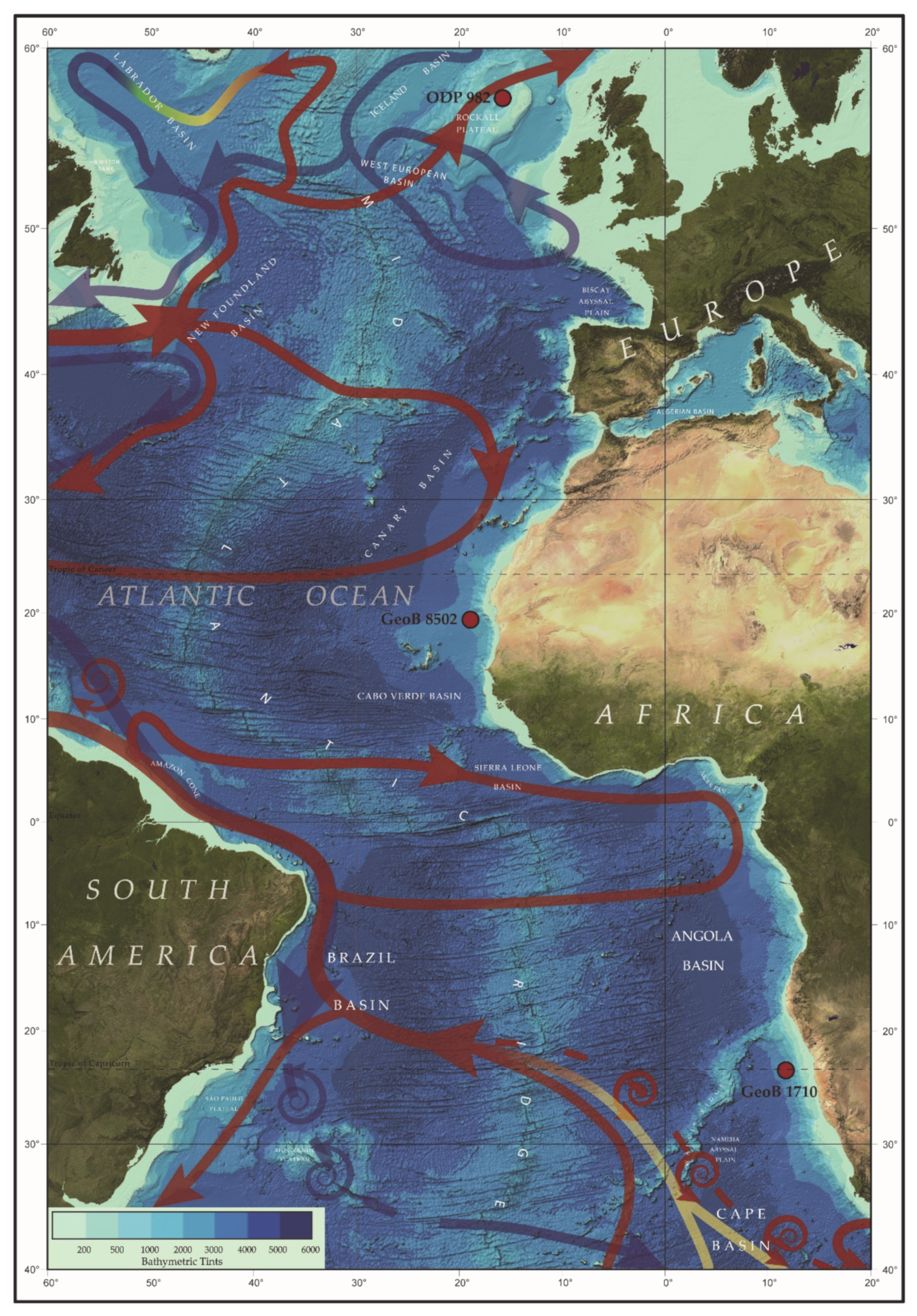
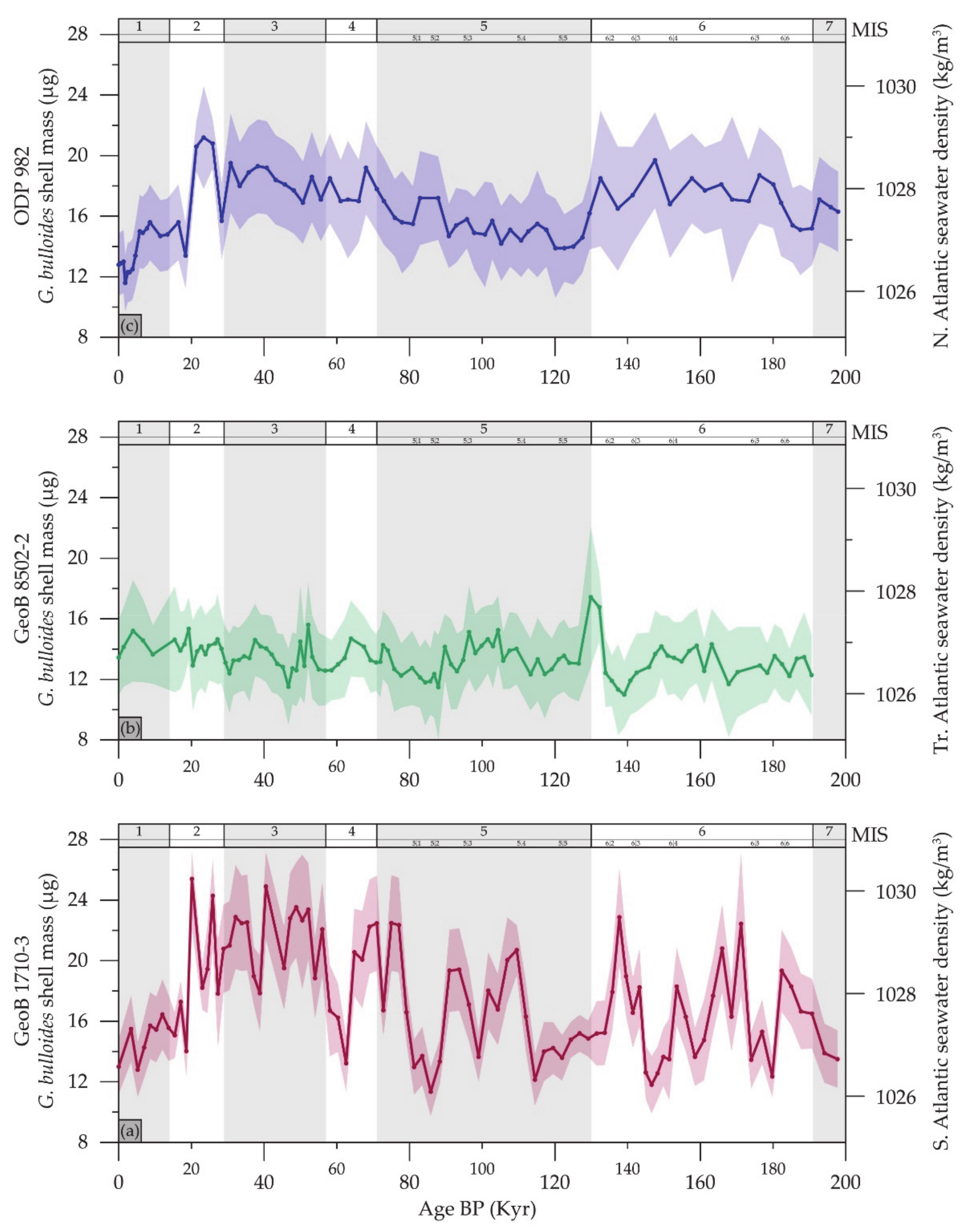
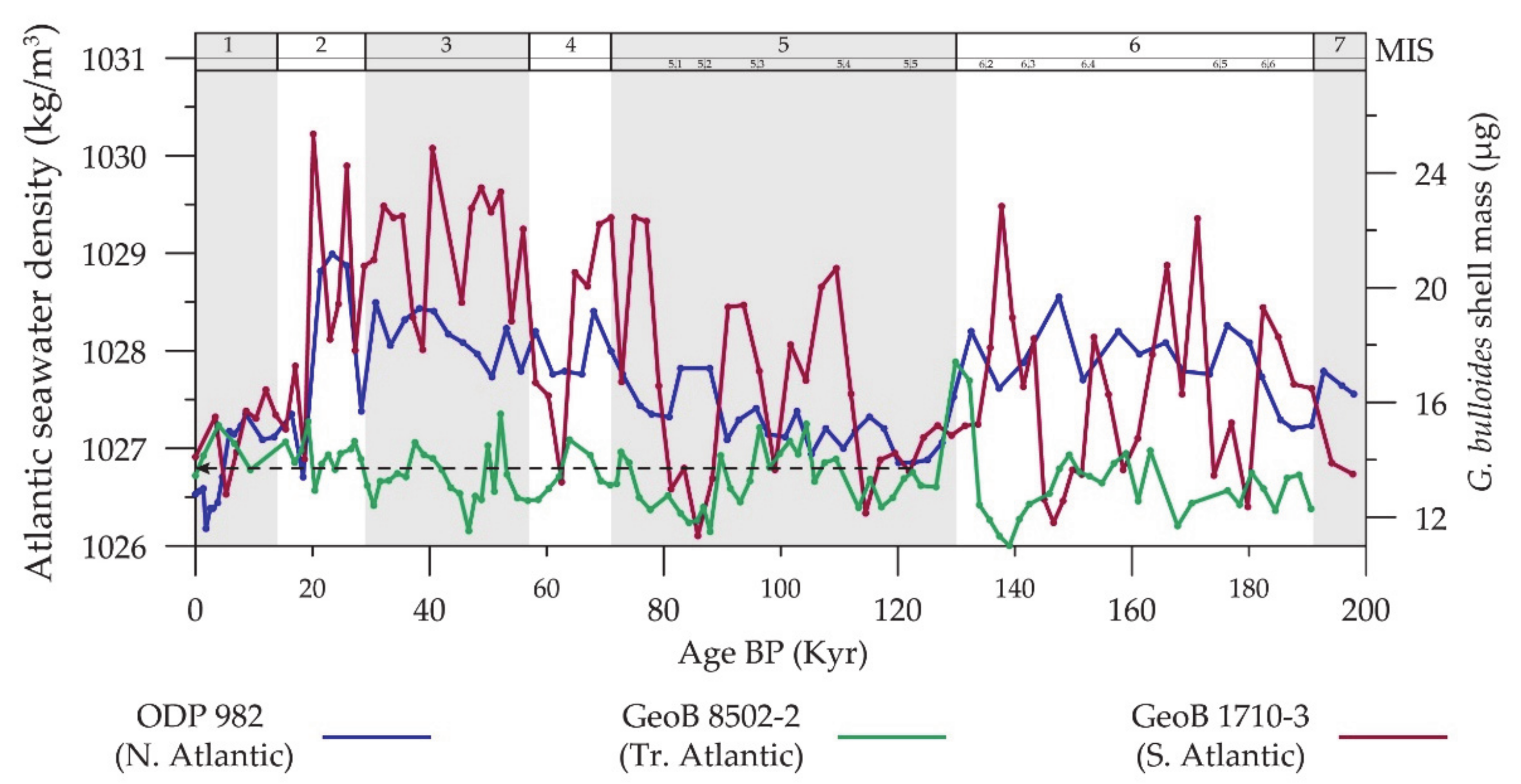
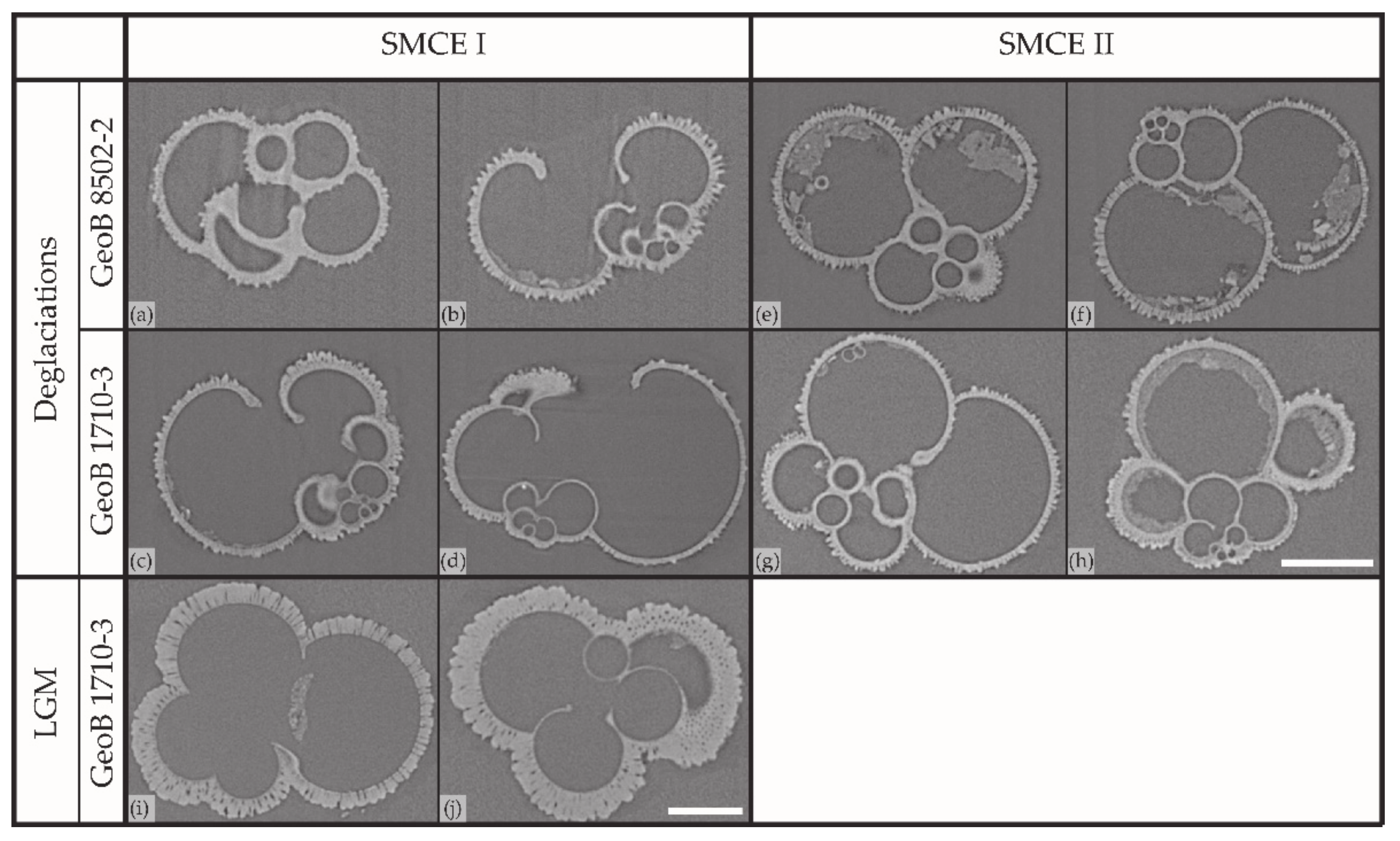
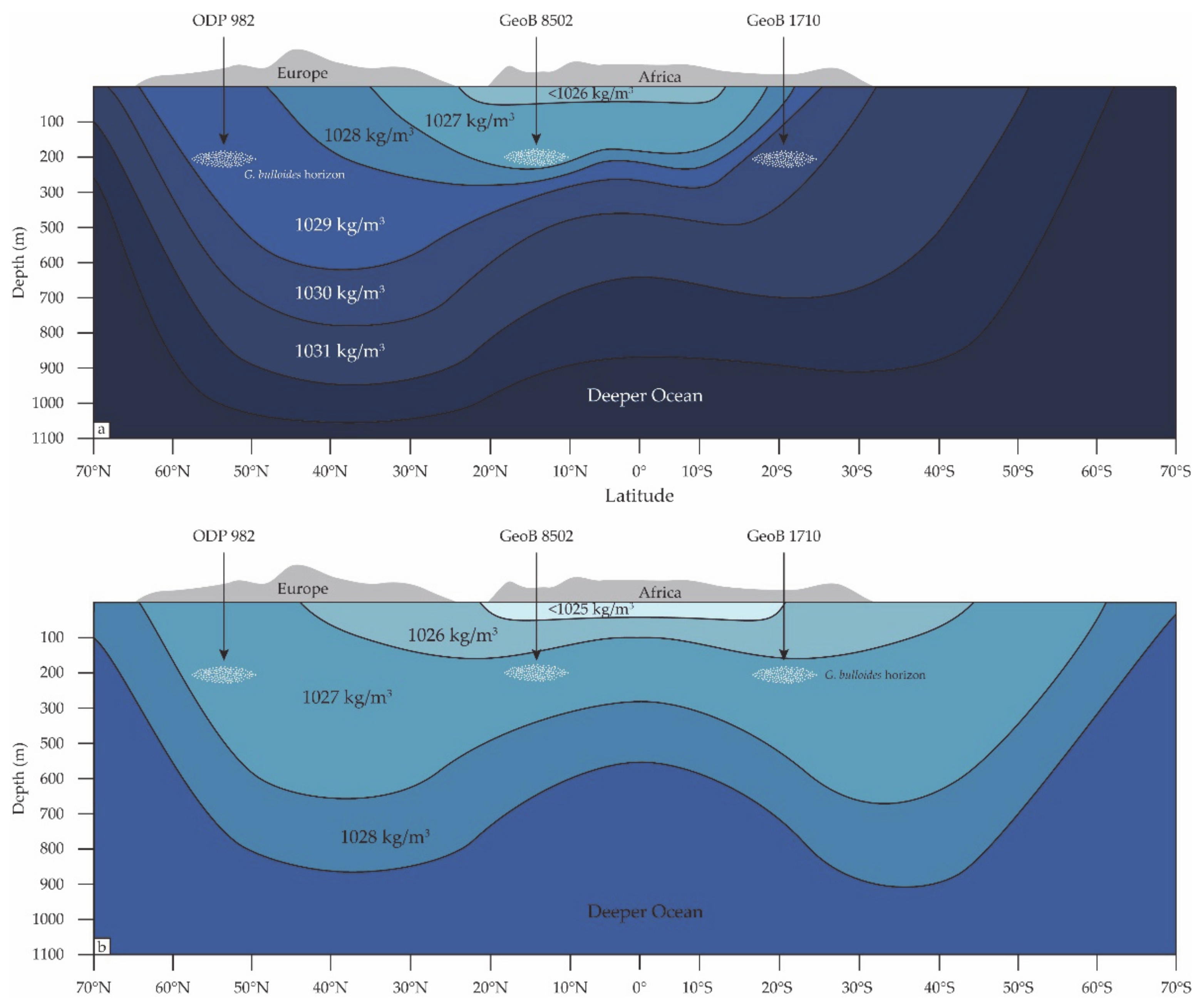
| Core | Latitude | Longitude | Depth (m) |
|---|---|---|---|
| ODP 982A | 57°30.99’ N | 15°52.00’ W | 1135 |
| GeoB 8502-2 | 19°13.27’ N | 18°56.04’ W | 2956 |
| GeoB 1710-3 | 23°25.9’ S | 11°41.9’ E | 2987 |
| SMCE I—Last Deglaciation | SMCE II—Penultimate Deglaciation | ||||||
|---|---|---|---|---|---|---|---|
| Sites | Age (ka) | Weight (μg) | Derived Density (kg/m3) | Age (ka) | Weight (μg) | Derived Density (kg/m3) | Reconstructed Density (kg/m3) |
| ODP 982A | 16.42 | 15.6 | 1027.35 | 120.12 | 13.9 | 1026.85 | |
| 18.40 | 13.4 | 1026.71 | 122.60 | 13.9 | 1026.85 | ||
| 21.38 | 20.6 | 1028.82 | 125.08 | 14.0 | 1026.88 | ||
| GeoB 8502-2 | 16.95 | 13.9 | 1026.85 | 121.08 | 13.3 | 1026.69 | 1027.21 |
| 18.10 | 14.3 | 1026.98 | 122.51 | 13.6 | 1026.76 | 1026.10 | |
| 19.26 | 15.3 | 1027.28 | 123.93 | 13.1 | 1026.62 | 1027.14 | |
| GeoB 1710-3 | 17.08 | 17.3 | 1027.84 | 119.49 | 14.2 | 1026.95 | |
| 18.65 | 14.0 | 1026.89 | 121.96 | 13.6 | 1026.76 | ||
| 20.15 | 25.4 | 1030.22 | 124.40 | 14.8 | 1027.11 | ||
| Period | Site | Age (kyrs) | Test Mass (μg) | Test Thickness (μm) | Cell Volume (μm3) | Sediment Infilling (%) | Test % | Shell Density (g/cm3) | Test Density (g/cm3) |
|---|---|---|---|---|---|---|---|---|---|
| Last Deglaciation | GeoB 8502 | 18.10 | 14.3 ± 2.2 | 5.1 ± 0.7 | 21,737,763 ±15% | 4% | 23% | 0.66 | 2.71 |
| GeoB 1710 | 18.65 | 14.0 ± 1.7 | 4.7 ± 0.5 | 24,155,433 ± 7% | 2% | 22% | 0.58 | 2.69 | |
| Penultimate Deglaciation | GeoB 8502 | 122.51 | 13.6 ± 2.4 | 5.0 ± 0.4 | 22,326,089 ± 9% | 5% | 23% | 0.61 | 2.62 |
| GeoB 1710 | 121.96 | 13.6 ± 1.5 | 5.2 ± 0.7 | 21,270,578 ± 10% | 7% | 25% | 0.64 | 2.60 | |
| Last Glacial Maximum | GeoB 1710 | 20.15 | 25.4 ± 0.5 | 11.0± 17% | 27,088,617± 6% | 6% | 42% | 0.94 | 2.24 |
Publisher’s Note: MDPI stays neutral with regard to jurisdictional claims in published maps and institutional affiliations. |
© 2021 by the author. Licensee MDPI, Basel, Switzerland. This article is an open access article distributed under the terms and conditions of the Creative Commons Attribution (CC BY) license (https://creativecommons.org/licenses/by/4.0/).
Share and Cite
Zarkogiannis, S.D. Disruption of the Atlantic Meridional Circulation during Deglacial Climates Inferred from Planktonic Foraminiferal Shell Weights. J. Mar. Sci. Eng. 2021, 9, 519. https://doi.org/10.3390/jmse9050519
Zarkogiannis SD. Disruption of the Atlantic Meridional Circulation during Deglacial Climates Inferred from Planktonic Foraminiferal Shell Weights. Journal of Marine Science and Engineering. 2021; 9(5):519. https://doi.org/10.3390/jmse9050519
Chicago/Turabian StyleZarkogiannis, Stergios D. 2021. "Disruption of the Atlantic Meridional Circulation during Deglacial Climates Inferred from Planktonic Foraminiferal Shell Weights" Journal of Marine Science and Engineering 9, no. 5: 519. https://doi.org/10.3390/jmse9050519
APA StyleZarkogiannis, S. D. (2021). Disruption of the Atlantic Meridional Circulation during Deglacial Climates Inferred from Planktonic Foraminiferal Shell Weights. Journal of Marine Science and Engineering, 9(5), 519. https://doi.org/10.3390/jmse9050519






